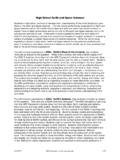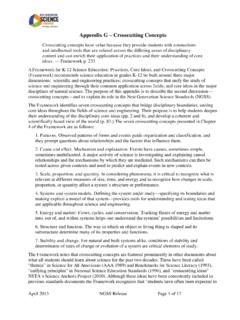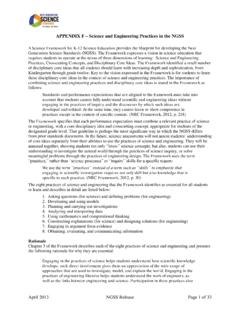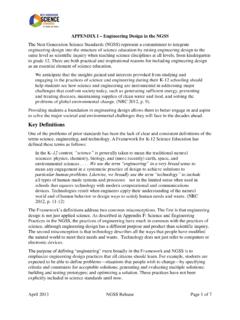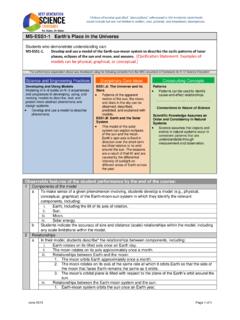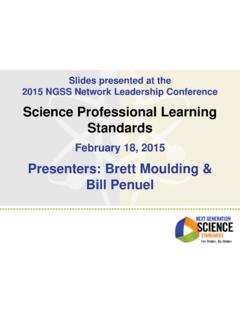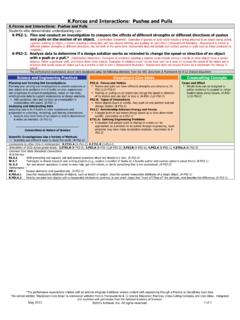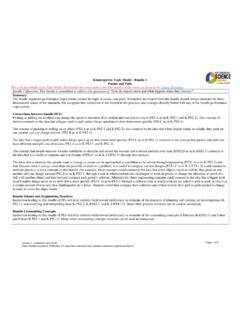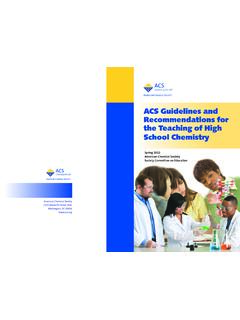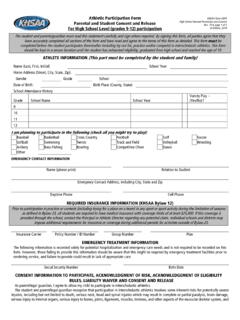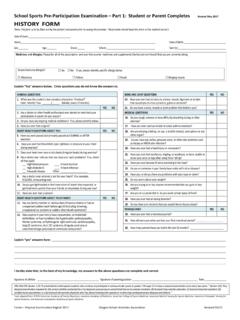Transcription of High School Life Science
1 high School Life Sciences Students in high School develop understanding of key concepts that help them make sense of life Science . The ideas are building upon students Science understanding of disciplinary core ideas, Science and engineering practices, and crosscutting concepts from earlier grades. There are five life Science topics in high School : 1) Structure and Function, 2) Inheritance and Variation of Traits, Matter and Energy in Organisms and Ecosystems, 4) Interdependent Relationships in Ecosystems, and 5) Natural Selection and Evolution. The performance expectations for high School life Science blend core ideas with scientific and engineering practices and crosscutting concepts to support students in developing useable knowledge that can be applied across the Science disciplines. While the performance expectations in high School life Science couple particular practices with specific disciplinary core ideas, instructional decisions should include use of many practices underlying the performance expectations.
2 The performance expectations are based on the grade-band endpoints described in A Framework for K-12 Science Education (NRC, 2012). The performance expectations in the topic Structure and Function help students formulate an answer to the question: How do the structures of organisms enable life s functions? high School students are able to investigate explanations for the structure and function of cells as the basic units of life, the hierarchical systems of organisms, and the role of specialized cells for maintenance and growth. Students demonstrate understanding of how systems of cells function together to support the life processes. Students demonstrate their understanding through critical reading, using models, and conducting investigations. The crosscutting concepts of structure and function, matter and energy, and systems and system models in organisms are called out as organizing concepts.
3 The performance expectations in the topic Inheritance and Variation of Traits help students in pursuing an answer to the question: How are the characteristics from one generation related to the previous generation? high School students demonstrate understanding of the relationship of DNA and chromosomes in the processes of cellular division that pass traits from one generation to the next. Students can determine why individuals of the same species vary in how they look, function, and behave. Students can develop conceptual models for the role of DNA in the unity of life on Earth and use statistical models to explain the importance of variation within populations for the survival and evolution of species. Ethical issues related to genetic modification of organisms and the nature of Science can be described. Students can explain the mechanisms of genetic inheritance and describe the environmental and genetic causes of gene mutation and the alteration of gene expression.
4 Crosscutting concepts of structure and function, patterns, and cause and effect developed in this topic help students to generalize understanding of inheritance of traits to other applications in Science . The performance expectations in the topic Matter and Energy in Organisms and Ecosystems help students answer the questions: How do organisms obtain and use energy they need to live and grow? How do matter and energy move through ecosystems? high School students can construct explanations for the role of energy in the cycling of matter in organisms and ecosystems. They can apply mathematical concepts to develop evidence to support explanations of the interactions of photosynthesis and cellular respiration and develop June 2013 2013 Achieve, Inc. All rights reserved. 1 of 11 models to communicate these explanations. They can relate the nature of Science to how explanations may change in light of new evidence and the implications for our understanding of the tentative nature of Science .
5 Students understand organisms interactions with each other and their physical environment, how organisms obtain resources, change the environment, and how these changes affect both organisms and ecosystems. In addition, students can utilize the crosscutting concepts of matter and energy and Systems and system models to make sense of ecosystem dynamics. The performance expectations in the topic Interdependent Relationships in Ecosystems help students answer the question, How do organisms interact with the living and non-living environment to obtain matter and energy? This topic builds on the other topics as high School students demonstrate an ability to investigate the role of biodiversity in ecosystems and the role of animal behavior on survival of individuals and species. Students have increased understanding of interactions among organisms and how those interactions influence the dynamics of ecosystems.
6 Students can generate mathematical comparisons, conduct investigations, use models, and apply scientific reasoning to link evidence to explanations about interactions and changes within ecosystems. The performance expectations in the topic Natural Selection and Evolution help students answer the questions: How can there be so many similarities among organisms yet so many different plants, animals, and microorganisms? How does biodiversity affect humans? high School students can investigate patterns to find the relationship between the environment and natural selection. Students demonstrate understanding of the factors causing natural selection and the process of evolution of species over time. They demonstrate understanding of how multiple lines of evidence contribute to the strength of scientific theories of natural selection and evolution.
7 Students can demonstrate an understanding of the processes that change the distribution of traits in a population over time and describe extensive scientific evidence ranging from the fossil record to genetic relationships among species that support the theory of biological evolution. Students can use models, apply statistics, analyze data, and produce scientific communications about evolution. Understanding of the crosscutting concepts of patterns, scale, structure and function, and cause and effect supports the development of a deeper understanding of this topic. June 2013 2013 Achieve, Inc. All rights reserved. 2 of and Function * The performance expectations marked w ith an asterisk integrate traditional Science content w ith engineering through a P racti ce or D isciplinary C ore Idea. The section entitled Disciplinary Core Ideas is reproduced v erbatim from A F ramew ork for K -12 S cience E ducation: P ractices, C ross-C utting C oncepts, and C ore Ideas.
8 Integrated and reprinted w ith permission from the N ational A cademy of S ciences. and Function Students who demonstrate understanding can: HS-LS1-1. Construct an explanation based on evidence for how the structure of DNA determines the structure of proteins which carry out the essential functions of life through systems of specialized cells. [A ssessment Boundary : A ssessment does not include identification of specific cell or tissue ty pes, w hole body sy stems, specific protein structures and functions, or the biochemistry of protein sy nthesis.] HS-LS1-2. Develop and use a model to illustrate the hierarchical organization of interacting systems that provide specific functions within multicellular organisms. [C larification S tatement: E mphasis is on functions at the organism sy stem lev el such as nutrient uptake, w ater deliv ery , and organism mov ement in response to neural stimuli.]
9 A n example of an interacting sy stem could be an artery depending on the proper function of elastic tissue and smooth muscle to regulate and deliv er the proper amount of blood w ithin the circulatory sy stem.] [A ssessment Boundary : A ssessment does not include interactions and functions at the molecular or chemical reaction lev el.] HS-LS1-3. Plan and conduct an investigation to provide evidence that feedback mechanisms maintain homeostasis. [C larification S tatement: E xamples of inv estigations could include heart rate response to exercise, stomate response to moisture and temperature, and root dev elopment in response to w ater lev els.] [A ssessment Boundary: A ssessment does not include the cellular processes inv olv ed in the feedback mechanism.] The performance expectations abov e w ere dev eloped using the follow ing elements from the N RC document A F ramew ork for K-12 S cience E ducation: Science and Engineering Practices Developing and Using M odels M odeling in 9 12 builds on K 8 experiences and progresses to using, sy nthesizing, and dev eloping models to predict and show relationships among v ariables betw een sy stems and their components in the natural and designed w orld.
10 D ev elop and use a model based on ev idence to illustrate the relationships betw een sy stems or betw een components of a sy stem. (H S-LS 1-2) P lanning and C ar rying O ut Investigations P lanning and carry ing out in 9-12 builds on K-8 experiences and progresses to include inv estigations that prov ide ev idence for and test conceptual, mathematical, phy sical, and empirical models. P lan and conduct an inv estigation indiv idually and collaborativ ely to produce data to serv e as the basis for ev idence, and in the design: decide on ty pes, how much, and accuracy of data needed to produce reliable measurements and consider limitations on the precision of the data ( , number of trials, cost, risk, time), and refine the design accordingly . (H S-LS 1-3) C onstr ucting Explanations and Designing Solutions C onstructing explanations and designing solutions in 9 12 builds on K 8 experiences and progresses to explanations and designs that are supported by multiple and independent student-generated sources of ev idence consistent w ith scientific ideas, principles, and theories.
